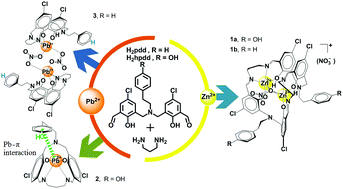36-Membered [2 + 2] half-fold Schiff-base macrocyclic dinuclear Zn(II) complexes (1a and 1b) and 18-membered [1 + 1] Schiff-base macrocyclic mononuclear Pb(II) complexes (2 and 3) are produced from the condensation between 1,3-propanediamine and a pair of extended dialdehydes with different functional pendant arms (H2hpdd and H2pdd) because of the distinguishable cationic template effects. It is very interesting to mention that a unique intramolecular Pb(II)–π macrocyclic complex 2 with an uncommon η3-coordination type is achieved under ambient conditions and it can remain stable both in the solid state and in solution. The subtle variations of pendant-arms in the macrocyclic ligands H2hpdd and H2pdd yield different Pb(II) complexes, where the competition between Pb(II)–π and Pb(II)–NO3− electrostatic interactions as well as the combination of steric and electronic effects of pendant arms are believed to play important roles.

